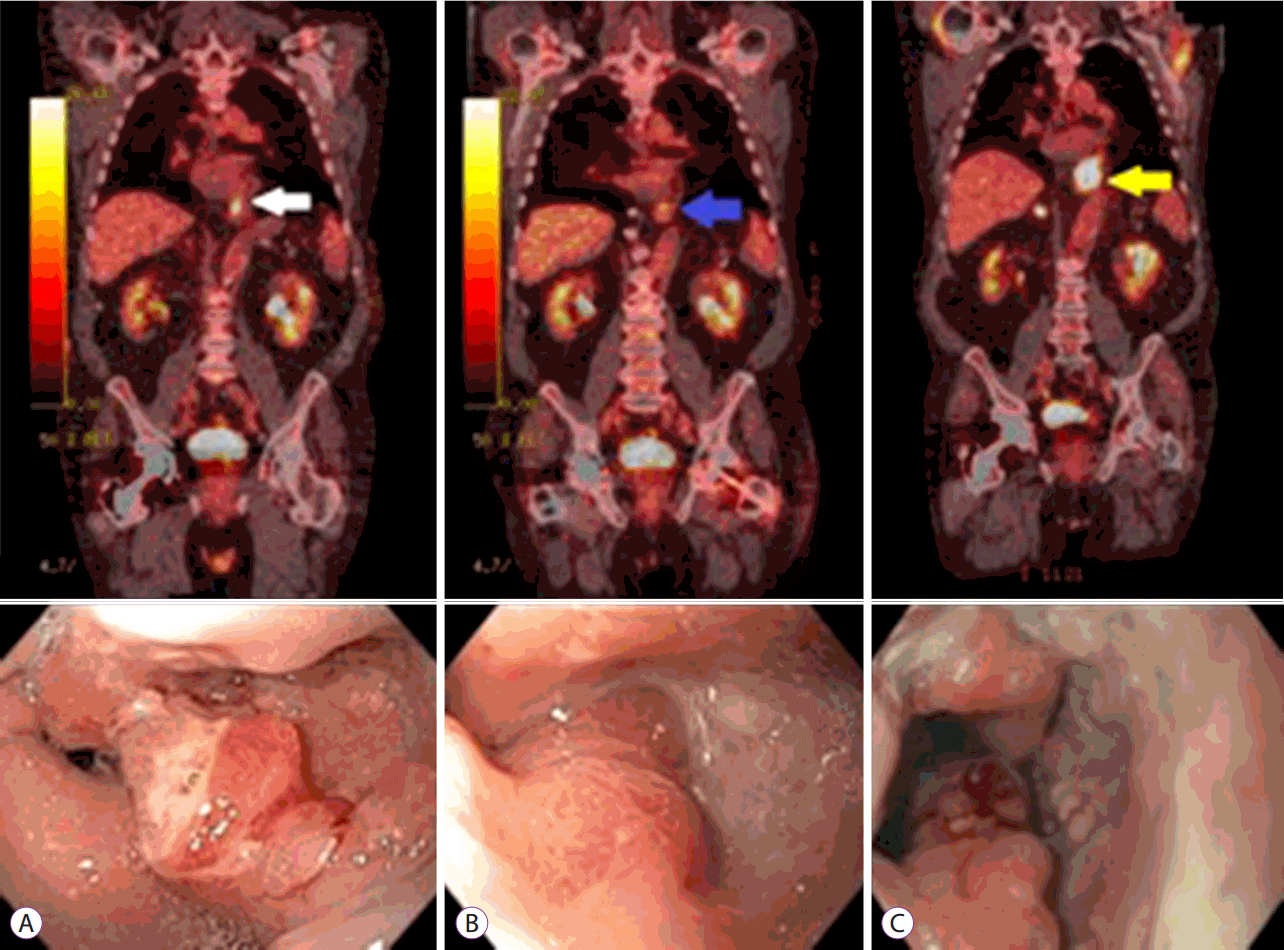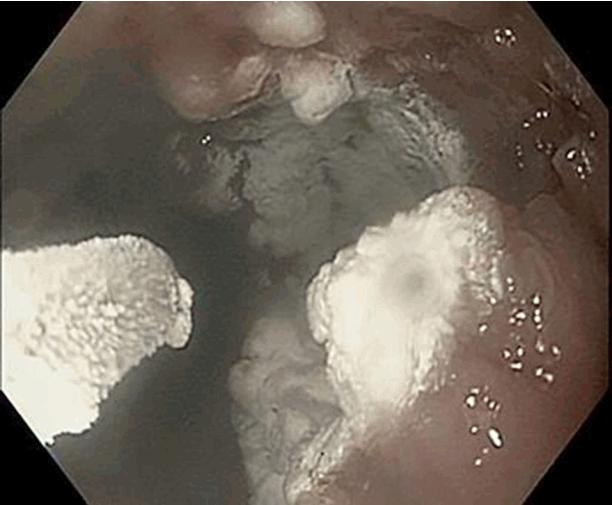Abstract
Esophageal cancer has a poor overall prognosis and is frequently diagnosed at a late stage. Conventional treatment for metastatic esophageal cancer involves chemotherapy and radiation. Local disease control plays a significant role in improving survival. Endoscopic spray cryotherapy is a novel modality that involves freezing and thawing to produce local ablation of malignant tissue via ischemic mechanisms. Spray cryotherapy has been shown to be effective, particularly for early T-stage, superficial esophageal adenocarcinomas. We present the case of a 72-year-old-male with locally recurrent stage IV esophageal adenocarcinoma and long-term survival of 7 years to date, with concurrent chemoradiation and serial cryoablation. He remains asymptomatic and continues to undergo chemotherapy and sequential cryoablation. The findings highlight the long-term safety and efficacy of cryotherapy in combination with chemoradiation, and suggest that cryoablation may have an additive role in the treatment of advanced stage esophageal adenocarcinoma.
Despite the increasing success of chemoradiation in inducing remission in esophageal cancer, the rate of recurrent disease remains as high as 60% [1]. Endoscopic cryotherapy is a novel ablative treatment that involves cycles of rapid freezing and thawing. This technique destroys tissues via ischemic mechanisms of vascular stasis, endothelial damage, and vascular thrombosis [2]. Cryotherapy causes damage to the cellular matrix and submucosal glands, while preserving underlying cartilage and parenchyma [3]. Cryoablation has been shown to be effective particularly for early T-stage, superficial esophageal cancers. Other techniques such as endoscopic mucosal resection and radiofrequency ablation are suitable for high-grade dysplasia and select superficial T1 tumors that do not penetrate into the deeper esophageal wall layers [3].
Cryotherapy has been studied in the short term for eradication of esophageal cancer, particularly in patients with T1 disease [4]. However, there are no reports to date on the long-term safety and efficacy of cryoablation in combination with chemoradiation for locally recurrent stage IV disease. This report describes a 72-year-old male with stage IV esophageal adenocarcinoma and long-term survival of 7 years from diagnosis to date, with serial cryoablation plus chemoradiation for locally recurrent metastatic disease. The findings highlight the long-term safety and efficacy of cryotherapy in combination with chemoradiation, and suggest that cryoablation may have a role in the treatment of more advanced stages of esophageal adenocarcinomas.
A 72-year-old Caucasian male was diagnosed with stage IV esophageal cancer after abdominal computed tomography (CT) for nephrolithiasis incidentally revealed retrocrural, periaortic, and retroperitoneal lymphadenopathy. A subsequent retroperitoneal lymph node biopsy demonstrated poorly differentiated adenocarcinoma with villoglandular and myxopapillary components. Immunohistochemical staining, positron emission tomography (PET), and endoscopy revealed a 1.9-cm T1b moderately to poorly differentiated adenocarcinoma in the distal esophagus as the primary source of the metastases. The tumor biopsy showed papillary and micropapillary growth patterns with lymphovascular invasion. Past medical history included type 2 diabetes and hypertension. He was a former smoker with a 20 pack-year smoking history and drank alcohol socially.
He underwent induction chemotherapy with 5 cycles of folinic acid, fluorouracil, and irinotecan (FOLFIRI) after initial diagnosis, but had disease progression. He received subsequent capecitabine and started radiation 5 months after diagnosis. Two months later, FOLFIRI was restarted for recurrent metastases to the lymph nodes in the chest and abdomen. He was changed to Taxotere due to gastrointestinal side effects, but had evidence of local disease progression after 6 cycles. He was then changed to folinic acid, fluorouracil, and oxaliplatin (FOLFOX). He completed 4 cycles, and had complete disease response 22 months after diagnosis. He did not receive further chemotherapy until a year later, when PET/CT showed local disease recurrence. Salvage esophagectomy was offered by the cardiothoracic surgeon, but he declined. At this point, alternative therapies were discussed, and he wished to pursue cryoablation in combination with further chemoradiation. He began spray cryoablation (truFreeze®; CSA Medical, Lexington, MA, USA) 40 months after diagnosis.
The first spray cryoablation for palliation and tumor debulking revealed a 1.5-cm mass involving 30% of the esophageal circumference. After the first cryoablation, the exophytic mass was no longer seen on endoscopy during 3 subsequent cryotherapy treatments over the next 3 months. PET/CT showed a decrease in size and uptake of the primary tumor (Fig. 1). Cryoablation was performed on irregular appearing mucosa in the distribution of the previously imaged mass during the endoscopies. The tumor reappeared on PET/CT 8 months after the first cryotherapy treatment.
He underwent a total of 18 cryoablation sessions over the following 4 years. During each treatment, the tumor was frozen completely (Fig. 2). Cryoablation treatments ranged from 2 cycles of 30 seconds each to 5 cycles of 20 seconds each. The patient did not experience any side effects from the cryoablation. Over the course of treatment, he remained able to swallow without dysphagia or odynophagia and has not required esophageal stenting or alternative means of nutrition such as a percutaneous gastrostomy tube. While undergoing serial cryotherapy ablations, he completed a concurrent course of 8 more cycles of FOLFOX, followed by 11 cycles of FOLFIRI, and was eventually changed to ramucirumab. He has maintained an Eastern Cooperative Oncology Group (ECOG) performance status score of 0 to 1 throughout the treatment.
The overall prognosis in stage IV esophageal adenocarcinoma remains poor. The estimated 5-year mortality for stage IV disease exceeds 85% to 90% [5]. Following diagnosis, many patients suffer significant comorbidities and require interventions such as esophageal stenting and feeding tube placement. A significant factor in improving survival after chemoradiation involves local disease control [1]. The present case demonstrates the long-term safety and efficacy of adjunctive cryoablation in combination with concurrent chemoradiotherapy for local control of recurrent esophageal cancer. Over the treatment course, the primary tumor increased slowly in length; however, chemo-cryo-radiotherapy appeared to maintain disease control. The patient remained asymptomatic, without requiring nutritional support, and had an ECOG performance status of 0–1 for 7 years following initial diagnosis.
Cryotherapy for esophageal cancer has been found to be effective for local tumor eradication [4]. In a 2010 multicenter, retrospective study, 79 patients with esophageal carcinoma underwent cryotherapy, and had biopsy-confirmed, complete eradication of luminal cancer. Of 49 patients, 30 (61%) demonstrated a complete response to cryotherapy. Among those with early tumors, 72.2% with T1 stage disease had complete endoscopic response. In safety analysis, no serious adverse events were reported. Benign strictures occurred in 13% of the patients [4].
This patient underwent concomitant chemoradiation therapy, which also likely augmented disease control. He received a standard platinum- and fluorouracil-based regimen for esophageal adenocarcinoma [5]. He was initially treated with FOLFIRI which has been studied in gastroesophageal junction cancer, and has a response rate, time to progression, and median survival similar to those of platinum and 5- fluorouracil-based regimens [5]. He was subsequently changed to FOLFOX. He underwent standard external beam radiation of 50.4 total Gy, with 36 fractions of 1.8 Gy per fraction over 2 months. The chemotherapy and radiation conformed to standard regimens, with the addition of serial cryoablation. We believe that cryoablation may have a synergistic effect in combination with chemoradiotherapy, and that the effects of combination treatment likely contributed to the favorable disease course and long-term survival,
Long-term follow-up allowed for longitudinal evaluation of the safety profile of cryotherapy ablation. After 18 treatments, the patient has not experienced any side effects. When comparing spray cryotherapy to other endoscopic treatments for esophageal adenocarcinoma, there appears to be a very low adverse event rate. Salvage photodynamic therapy after chemoradiation has side effects including esophageal stenosis (23%–100% of patients), cutaneous phototoxicity, perforation, mediastinitis, and pleural effusion. Endoscopic mucosal resection is an excellent therapeutic approach for high-grade dysplasia and early T-stage tumors, but does not play a role in the treatment of T2-T4 cancers [3].
The findings in this case suggest that cryotherapy is a safe adjunct and viable long-term addition for local control of recurrent esophageal cancer in combination with concurrent chemoradiation, and may offer palliative benefit. The patient in this case remained free of obstruction and did not require a feeding tube or stent placement. It is not yet clear whether the addition of routine cryotherapy to standard chemoradiation yields a survival benefit; however, cryotherapy it is a potential additional measure which could be offered and studied in a cohort of patients with an otherwise poor long-term prognosis.
ACKNOWLEDGMENTS
This report was supported in part by a development grant from the Department of Medicine at Emory University School of Medicine.
REFERENCES
1. Khangura SK, Greenwald BD. Endoscopic management of esophageal cancer after definitive chemoradiotherapy. Dig Dis Sci. 2013; 58:1477–1485.

2. Greenwald BD, Dumot JA. Cryotherapy for Barrett’s esophagus and esophageal cancer. Curr Opin Gastroenterol. 2011; 27:363–367.

3. Gan S, Watson DI. New endoscopic and surgical treatment options for early esophageal adenocarcinoma. J Gastroenterol Hepatol. 2010; 25:1478–1484.

4. Greenwald BD, Dumot JA, Abrams JA, et al. Endoscopic spray cryotherapy for esophageal cancer: safety and efficacy. Gastrointest Endosc. 2010; 71:686–693.

5. Ilson DH. Esophageal cancer chemotherapy: recent advances. Gastrointest Cancer Res. 2008; 2:85–92.
Fig. 1.
(A) Positron emission tomography-computed tomography and endoscopic images demonstrating recurrent tumor after 1 year of chemoradiation to the distal esophagus (white arrow). (B) Tumor significantly regressed after cryoablation ×2 (blue arrow). (C) Most recent imaging 7 years after concomitant chemotherapy and serial cryoablation (yellow arrow).





 PDF
PDF Citation
Citation Print
Print



 XML Download
XML Download